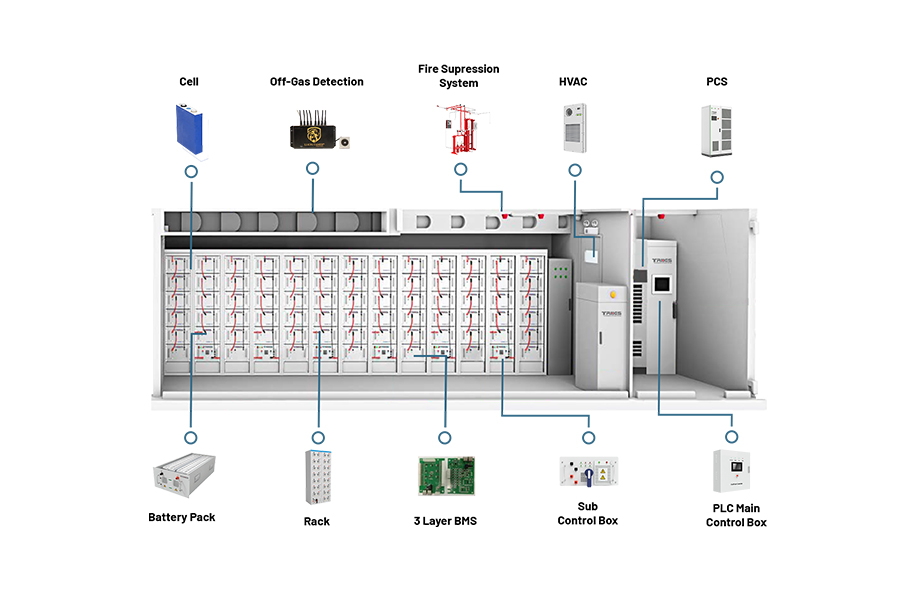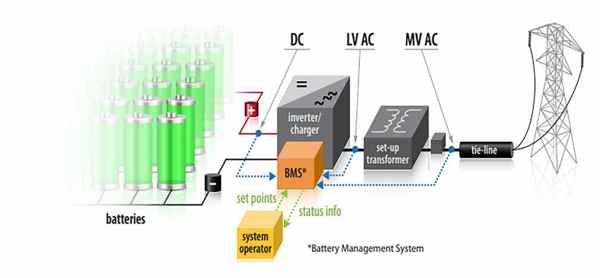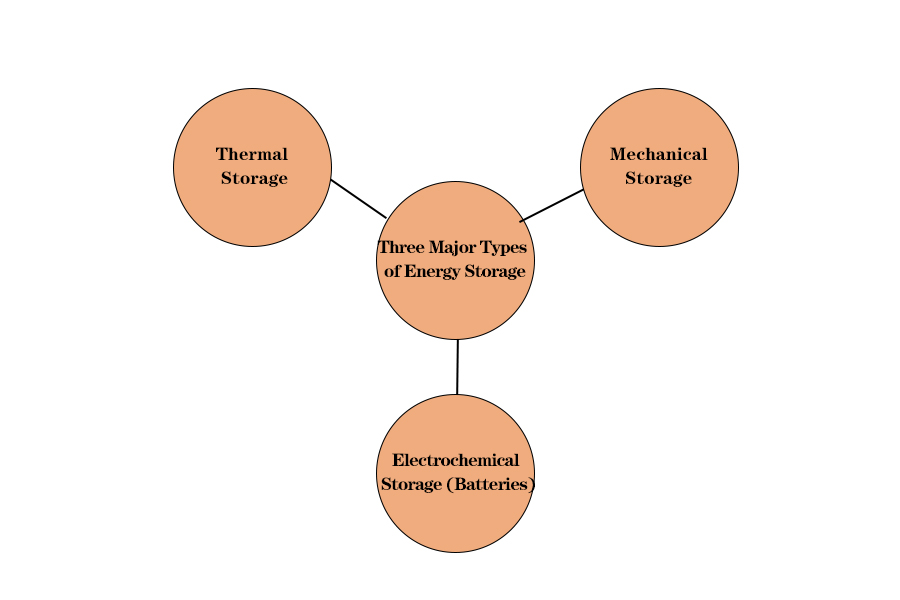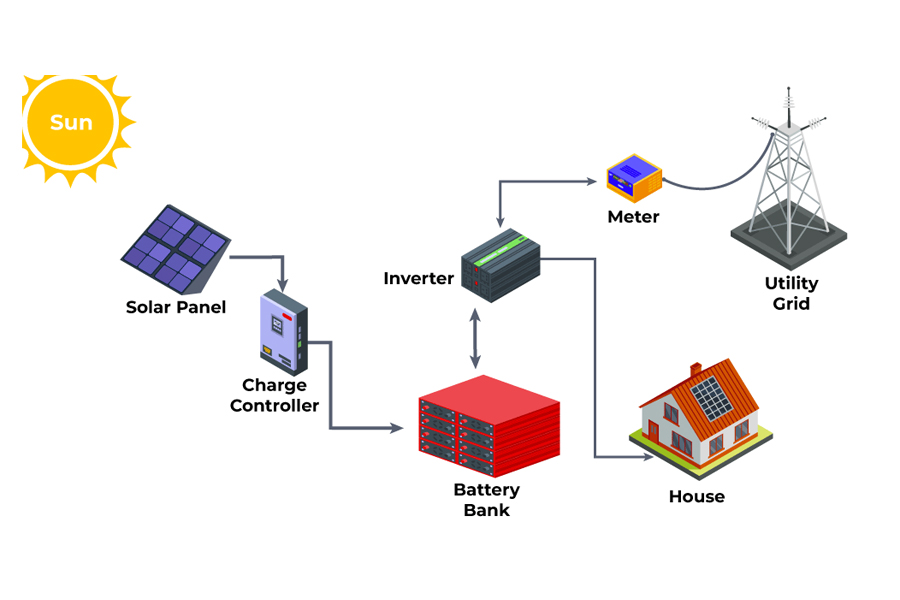电池和贝斯有什么区别?
您是否在探索储能选项,发现自己在术语中有些纠结? 您可能会听到“电池" 和“贝丝" 用过的, 有时会互换, 但是他们真的是同一件事吗? 了解这种区别对于做出有关您的能量未来的明智选择至关重要, 是否为您的家, 商业, 或更大的项目.
最简单的方法是“电池”" (或更准确, 电池和模块) 是化学存储电能的核心成分. 将其视为油箱. 贝丝 (电池储能系统), 另一方面, 是整个, 完全集成的解决方案不仅包括电池,还包括复杂的电池管理系统 (电池管理系统), 电源转换系统 (件) 像逆变器, 关键控制软件, 以及所有必要的安全和辅助组件. 贝丝是完整的, 操作“引擎" 准备连接并传递电力.

在 吉克斯太阳能, 我们设计并安装了全面的贝斯解决方案. 虽然电池本身至关重要, 所有系统组件的智能集成可以解锁真正的能源独立性, 效率, 和客户的安全.
让我们更深入地研究贝斯的真实含义,并回答一些常见的问题.
什么是BESS储能系统?
您已经听到了首字母缩略词Bess, 但是它真正涵盖了什么? 是什么使它不仅仅是一个大电池? 电池储能系统是一个复杂的, 自包含的解决方案,旨在在丰富时储存电能 (就像白天的太阳能电池板一样, 或在非高峰时段的网格中) 然后在需要时释放.
Bess是一个完全集成的系统,可以智能管理存储的能源. 它的核心组件包括:
- 电池模块: 这些包含实际的电池电池 (通常,磷酸锂以实现现代贝斯的安全性和寿命).
- 电池管理系统 (电池管理系统): 关键的“大脑" 用于电池, 确保它们通过监视温度安全有效地运行, 电压, 当前的, 和平衡细胞.
- 电源转换系统 (件): 这通常是双向逆变器/整流器, 并转换交流电源 (来自太阳能或网格) DC电源为电池充电.
- 控制系统 & 软件: 管理整体操作, 决定何时充电, 释放, 并与其他能源(如太阳能或网格)互动.
- 安全 & 辅助组件: 包括断路器, 保险丝, 热管理 (冷却/加热系统), 并且经常针对大型单位进行火灾检测/抑制, 全部安装在保护性围墙内.

深入潜水: 协调的强国
贝斯不仅是一个被动能源储层; 这是一个活跃的, 您的能量生态系统的智能部分. 这 电池模块 是化学存储的能量的地方. 这 电池管理系统 充当他们敬业的监护人, 不断监视其生命体征, 保护它们免受过度充电等条件, 过度放电, 极端温度, 或过多的电流. 它还执行细胞平衡, 这对于最大化锂离子电池组的寿命至关重要, 特别是LFP.
这 件 (逆变器) 是来回转换电力的主力. 对于太阳能贝斯, 混合逆变器通常用作PC, 管理太阳能电池板之间的能量流, 电池, 网格, 和您的负载. 这 控制系统 是使贝丝聪明的原因. 可以编程以优化用于太阳能自我消费 (存储过多的太阳能而不是导出), 在中断期间提供备份功率, 甚至从事剃须 (通过在高成本期间排放存储的能源来减少企业昂贵的高峰需求费用).
所有这些组件都合在一起, 通常,在用于住宅系统的时尚围栏中,用于商业和公用事业规模应用, 配有必要的安全机制,例如热管理,以使电池在其理想温度范围内保持运行.
在GYCX太阳能, 当我们谈论提供储能解决方案时, 我们正在谈论提供完整的, 根据您的特定需求量身定制的专业设计的Bess.
三种储能的三种类型是?
而电池是一个热门话题, 有趣的是,他们只是人类弄清楚如何存储能量的一种方式. 当我们看更广阔的图片时, 当今使用的主要类别或类型是什么?
有几种分类存储的方法, 但是经常讨论的三个主要类别是:
- 电化学存储: 这是电池的地方, 包括Bess中使用的锂离子和铅酸类型, 落下. 能量是通过化学反应存储的.
- 机械存储: 这涉及存储潜力或动能. 例子包括抽水的水力储存 (PHS), 飞轮, 和压缩空气存储 (计算机辅助电子学1. ).
- 热存储: 这涉及以热或冷的形式存储能量, 例如用于浓缩太阳能的熔融盐存储或用于冷却的冰储存.
对于大多数现场应用程序,例如住宅太阳能存储或商业备用功率 - 类型的系统GYCX太阳能专业 - 电化学存储 (具体来说, LFP等高级电池) 目前是最实用的, 可扩展, 并广泛采用的技术.

深入潜水: 更广泛地看待能源
让我们简要探索这些类别:
- 电化学存储 (电池): 这是现代贝斯的核心技术.
- 它如何工作: 通过氧化还原反应放电期间,在充电过程中将电能转换为化学能.
- 例子: 锂离子 (磷酸铁锂, 国家管理委员会, 液态二氧化碳), 铅酸, 液流电池, 钠离子电池.
- 优点: 其尺寸/重量的高能量密度 (特别是锂离子), 从小设备到公用事业规模的模块化和可扩展, 快速响应时间, 并不断降低成本.
- 缺点: 有限寿命,降解在周期上, 一些原材料采购问题 (尽管LFP减轻了其中一些), 和寿命末回收挑战 (正在改善).
- 机械存储:
- 泵送水力储存 (PHS): 目前,全球网格尺度储能的最大形式. 当电力廉价/丰富时,将水泵送到水库,并通过涡轮机释放,以便在需要时发电. 高效但地理限制和大型资本投资.
- 飞轮: 将动能存储在快速旋转的转子中. 非常短的时间, 高功率应用,例如频率监管或关键工业流程的UPS. 限量存储容量.
- 压缩空气存储 (计算机辅助电子学): 空气被压缩并存储在地下洞穴或坦克中, 然后加热并通过涡轮机发电以发电. 大规模, 地理依赖.
- 热存储:
- 熔融盐: 用于集中的太阳能 (CSP) 储存太阳热的植物, 即使太阳没有闪耀,也可以发电.
- 冰存储 / 冷水: 用于空调的大型建筑物. 冰是在非高峰期间制造的 (便宜的电力) 小时,然后在高峰时间用于冷却建筑物.
- 其他形式: 我们也可以提到 化学存储 (像氢, 电力用于通过电解产生氢的地方, 然后可以将其存储并在燃料电池或涡轮机中使用) 和 电气存储 直接在电场 (电容器) 或磁场 (超导磁能存储 - 中小企业), 尽管电容器/超级电容器比电池储存的能量更少,但可以很快放电.
对于绝大多数住宅和商业贝斯应用程序, 特别是与太阳能PV配对时, 高级锂离子电池提供了最佳的能量密度组合, 循环寿命, 安全, 可伸缩性, 今天可用的成本效益.
BMS和BESS有什么区别?
我们已经谈到了这些首字母缩写词, BMS和Bess, 但这是一个普遍的混乱点. 他们如何相互关系, 他们在储能设置中的独特角色是什么? 一个是关键的内部组件, 而另一个是整个操作系统.
A 贝斯 (电池储能系统) 是 完全的, 集成系统 这存储电能并在需要时提供. 它包括电池, 电源转换电子设备, 控制软件, 安全功能, 和住房. 这 电池管理系统 (电池管理系统) 是必不可少的 电子子系统 之内 贝斯. 它充当敬业的“大脑" 或电池模块本身的监护人, 确保他们的安全, 高效的, 和通过不断监视和管理参数(例如单个电池电压)来进行最佳操作, 电流流, 和温度.

深入潜水: 系统及其守护天使
这样想:
- 贝斯 - 完整的车辆: 想象一辆复杂的电动汽车. Bess类似于整个汽车 - 底盘, 电动机 (就像贝斯中的PC/逆变器一样), 车轮, 转向, 安全系统, 车身, 和, 当然, 电池组. 这是您使用存储的能量从A点到B点所需的一切.
- BMS - 发动机控制单元 (ECU) 用于电池: 该电动汽车中的电池组由许多单个单元组成. BMS就像一台高度专业的计算机 (ECU) 这是专门用于管理该电池组的. 它不会开车 (PC/逆变器和整体车辆控制器这样做), 但这确保了“引擎" (电池组) 正在安全运行, 有效, 并且不会损坏自己.
这是每个人所做的回顾:
- Bess包括:
- 电池模组 (核心储能单元)
- BMS本身
- 电源转换系统 (PC - 逆变器/整流器)
- 热管理 (冷却/加热)
- 安全机制 (保险丝, 断路器, 在某些情况下抑制火灾)
- 整体系统操作的控制软件
- 物理外壳
- BMS功能专门针对电池:
- 保护: 反对过度充电的警卫, 过度关闭, 过电流, 过度的温度, 和温度下的条件.
- 细胞平衡: 积极或被动地确保电池组中的所有电池保持在类似的充电状态, 这对于锂离子化学的健康和寿命至关重要, 特别是LFP.
- 监视 & 估计: 计算和报告费用状态 (片上系统), 健康状况 (索赫), 和其他诊断数据.
- 沟通: 继电器电池状态和警报到PC和整个BESS控制器, 通常使闭环控制能够优化和放电.
GYCX太阳能故事: 我们曾经有一个年龄较大的客户, 非GYCX电池系统 (具有非常基本的BMS) 经历了过早失败,因为某些细胞失去了平衡.
当我们用混合LFP电池的现代BES代替它时, 每个都有高级, 交流BMS, 客户立即看到了稳定性的差异和可用的详细健康信息.
它强调了良好的BM在长期可靠性的整体bess中的重要性.
强大的BMS绝对是安全,持久的Bess的基础.
BESS系统要花多少钱?
如果您正在考虑对可靠的储能进行投资, 电池存储系统的成本 (贝斯) 无疑是关键因素. 什么影响价格, 您可以期待什么样的范围?
贝斯的成本可能有很大差异, 从 较小的住宅系统几千美元 (例如, 大约 10-20 使用LFP化学) 到数十万甚至数百万的大型商业, 工业的, 或实用规模的安装. 成本的主要驱动力是 电池容量 (以千瓦时为单位), 这 功率输出能力 (在KW), 具体 电池化学和品牌, 的复杂性 BMS和电源转换系统 (PC/逆变器), 安装复杂性, 和任何 可用的经济激励措施,例如税收抵免或回扣, 这可以大大降低净投资. 当前在美国住宅LFP BES的插图安装成本, 在激励之前, 可能来自 $700 到 $1,200 每千瓦时, 但这可能会根据许多因素而波动 (来源: 能量, nrel, 直到).

深入潜水: 塑造贝斯价格标签的因素
让我们分解造成贝斯最终成本的元素:
- 电池容量 (千瓦时): 这通常是最大的成本组成部分. 更多的存储容量意味着更多的电池电池, 因此更高的材料和制造成本.
- 电力等级 (千瓦): PC (逆变器) 确定贝丝一次可以发射的力量. 较高的KW评级 (例如, 启动大型电器或提供大量的商业负荷) 意味着更强大,更昂贵的PC.
- 电池化学 & 质量: 铁磷酸锂 (磷酸铁锂) 由于其安全性是固定贝斯的常见选择, 循环寿命长, 以及竞争日益激烈的成本. 来自信誉良好的制造商的高质量细胞的成本比低级替代品的成本高,但具有更好的性能和寿命.
- 电池管理系统 & PCS功能: 更高级的BMS单元具有精确的监控和复杂的通信功能, 和具有网格形成功能或无缝太阳能集成等功能的高效PC单元, 增加费用.
- 系统平衡 (BOS): 这包括围栏, 热管理 (冷却/加热系统), 安全组件 (断路器, 断开连接, 大型单位的灭火), 接线, 和控制软件.
- 安装 & 调试: 专业安装的人工成本, 电气工作, 允许, 系统调试因位置和系统复杂性而异.
- 品牌 & 保修单: 拥有强大保证的建立品牌 (经常 10 电池组件的年份) 良好的客户支持通常以价格反映其质量和服务.
- 激励措施 (对于负担能力至关重要):
- 联邦投资税收抵免 (国贸中心): 在美国, ITC (目前 30% 基本费率) 可以大大降低贝斯的成本. 批判性, 多亏了降低通货膨胀法 2022, 现在,ITC也适用于 独立电池存储 (太阳能直接收费的系统, 满足某些尺寸标准) 用于服务中的系统 2023 向后, 除了太阳能收取的贝斯 (来源: 我们. 能源部, 直到). 这是贝丝采用的重大推动力.
- 状态 & 当地的激励措施: 许多州 (像加利福尼亚州的自我生成激励计划), 公用事业, 地方政府提供额外的回扣, 赠款, 或电池存储的税收抵免.
在GYCX太阳能, 我们提供全面的建议,详细介绍所有系统成本并清楚概述所有可用的激励措施. 我们的目标是帮助您了解贝丝(Bess)可以提供的全面财务状况和出色的长期价值, 通常导致节省能源账单并增强能源安全.
区分“电池”" 作为组件和“贝斯" 完整, 智能系统对于任何研究严重储能的人都至关重要.
贝斯将电池与关键管理集成, 转换, 和安全技术以提供可靠的力量, 优化能源使用, 并提供备份. 虽然投资可能很重要, 能源独立性方面的好处, 节省成本 (尤其是太阳能), 韧性越来越令人信服.
如果您准备探索如何根据您的特定需求来量身定制电池储能系统, 无论是住宅还是商业, GYCX太阳能的团队具有指导您的专业知识. 我们设计和安装高质量的Bess解决方案, 帮助您利用存储能量的力量. 立即与我们联系以进行查询!
了解与电池有关的技术术语,以便对锂电池数据概念有更好的比较理解. 这将帮助您选择一种更适合您需求的产品. ↩
